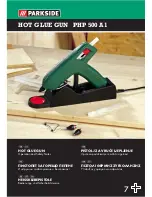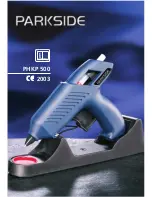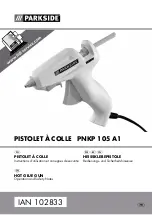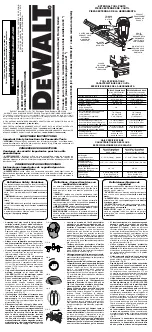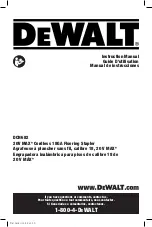
4.8.
CONTACT FIRING MODE SEE FIG.6:
Push the single/contact firing switch to the right side, see fig.2,
it is on Contact Firing mode.
Contact Firing is good for quick and convenient firing.
The trigger must be kept depressed all the time so that every time the safety
contact pin is depressed the tool is activated.
8
DO NOT
keep the trigger depressed when the tool is not in use or when it is in transit.
4.9.
DEPTH ADJUSTMENT WHEEL, FIG.1
4.9.1.
Depth adjustment helps protect work surface and allows proper setting of nail heads.
4.9.2.
Turn the depth adjustment wheel, see fig.1, to alter the depth of penetration of the nails/staples.
4.10.
REMOVING A JAMMED NAIL OR STAPLE SEE FIG’S 7&8
WARNING!
Never load fasteners with the workpiece contact or trigger activated. Doing so could result in possible serious personal injury.
NOTE:
You must remove any jammed nail/staple before using the tool any further.
Otherwise, it could cause damage to the mechanism.
WARNING!
Remove the battery pack from the tool.
4.10.1. Open the magazine, remove the staples or nails in channel.
Then, to remove the jammed fasteners.
4.10.2. If the fasteners remain jammed after following the above instructions, slightly loosen the four hex screws on the nose piece with the
wrench provided, take off the nose cover then remove the jammed fastener parts, see fig’s 7 and 8.
4.10.3. Remove the jammed nail with pliers if necessary. After the jammed nail has been successfully removed , then re-tighten the nose piece
with hex screws securely.
Sometimes after a jam, the driver remains stuck and does not return to its position. Take a flat screwdriver and push it back into place.
4.10.4. Reload the staples/nails, close the magazine, then insert the battery.
5. MAINTENANCE
Have your power tool serviced by a qualified repair person using only genuine replacement parts. This will ensure that the safety of the
power tool is maintained.
WARNING! – Risk of Hand Arm Vibration Injury.
This tool may cause Hand Arm Vibration Syndrome if its use is not managed adequately.
This tool is subject to the vibration testing section of the Machinery Directive 2006/42/EC.
This tool is to be operated in accordance with these instructions.
Measured vibration emission value (a): 1.39 m/s²
Uncertainty value (k): 1.5 m/s²
P
lease note that the application of the tool to a sole specialist task may produce a different average vibration emission. We recommend that a
specific evaluation of the vibration emission is conducted prior to commencing with a specialist task.
A health and safety assessment by the user (or employer) will need to be carried out to determine the suitable duration of use for each tool.
NB:
Stated Vibration Emission values are type-test values and are intended to be typical.
Whilst in use, the actual value will vary considerably from and depend on many factors.
S
uch factors include; the operator, the task and the inserted tool or consumable.
NB:
ensure that the length of leader hoses is sufficient to allow unrestricted use, as this also helps to reduce vibration.
T
he state of maintenance of the tool itself is also an important factor, a poorly maintained tool will also increase the risk of Hand Arm Vibration
Syndrome.
Health surveillance.
We recommend a programme of health surveillance to detect early symptoms of vibration injury so that management procedures can be modified
accordingly.
Personal protective equipment.
We are not aware of any personal protective equipment (PPE) that provides protection against vibration injury that may result from the
uncontrolled use of this tool. We recommend a sufficient supply of clothing (including gloves) to enable the operator to remain warm and dry and
maintain good blood circulation in fingers etc. Please note that the most effective protection is prevention, please refer to the Correct Use and
Maintenance section in these instructions. Guidance relating to the management of hand arm vibration can be found on the HSC website
www.hse.gov.uk - Hand-Arm Vibration at Work.
Original Language Version
© Jack Sealey Limited
CP20VNG Issue 2 (2,3) 24/05/21
fig.8
fig.7
Depress the safety contact pin
against the work piece to fire the nail
or staple; Keep squeezing the trigger
all the time but release safety contact
pin after firing.
Squeeze the trigger, keep squeezing
and don’t release.
fig.6






